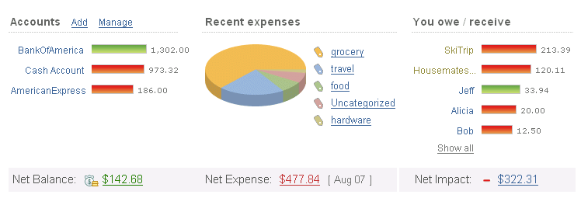 A number of well-executed personal finance management web startups have been in the spotlight in recent months, including Mint — which won the Techcrunch 40 startup competition — Wesabe and Geezeo. Buxfer, however, has been flying under the radar, and it shouldn’t be.
A number of well-executed personal finance management web startups have been in the spotlight in recent months, including Mint — which won the Techcrunch 40 startup competition — Wesabe and Geezeo. Buxfer, however, has been flying under the radar, and it shouldn’t be.
Beyond a clean interface for tracking your purchases, payments and trends in your spending habits (see screenshot, below), the company has been developing some impressive new features. One is a use of Google Gears that lets you store sensitive financial information on your machine, which is sure to please those concerned about online financial privacy. It also has new, useful Twitter and iPhone integration.
Also, Buxfer is a two-man team with only angel funding, facing large teams that have venture backing.
AI Weekly
The must-read newsletter for AI and Big Data industry written by Khari Johnson, Kyle Wiggers, and Seth Colaner.
Included with VentureBeat Insider and VentureBeat VIP memberships.
Like Mint and the others, Buxfer has introduced a way to let you easily synchronize your financial accounts from Bank of America, American Express, Citibank credit cards, Chase credit cards, and more than 300 others with your personal finance information on its site. It uses Google Gears to download your financial account information — your username and password — to an offline Buxfer component that lives on your computer, that syncs with your online Buxfer account. It’s the company’s policy to never store this sensitive user information on its servers. It accesses the data stored on your Google Gears database on your computer, and authenticates you and your information with your financial institution. You can delete the data or make it unavailable to Buxfer whenever you want.
Mint has received some heat from those concerned about letting a web startup store their personal data on its servers. Wesabe, like Buxfer, offers a set of financial information upload tools, so you can store your data on your own computer, then sync it with that site — we’ve found Buxfer’s implementation of this offline component to be easier to use.
For the more stylish geeks among us, Buxfer also offers iPhone and Twitter integration.
You can send transaction information to Buxfer and receive Buxfer alerts on Twitter (details here).
Last week, the company has released a Buxfer iPhone interface which it says has quickly become popular with its users.
When we first met the Buxfer team, almost a year ago, it was comprised of some grad student buddies who had developed a somewhat complicated interface for managing group purchases, instances like figuring out who owes who after a group dinner. While still a small site, the company has come a long way on a shoestring — considering the tiny team as well as the site’s many new features and constantly improving interface.
Buxfer first got seed funding from Y Combinator, then raised a $300,000 angel round last April, from Carnegie Mellon professor Eric Cooper and early Googler Georges Harik.
VentureBeat's mission is to be a digital town square for technical decision-makers to gain knowledge about transformative enterprise technology and transact. Learn More
